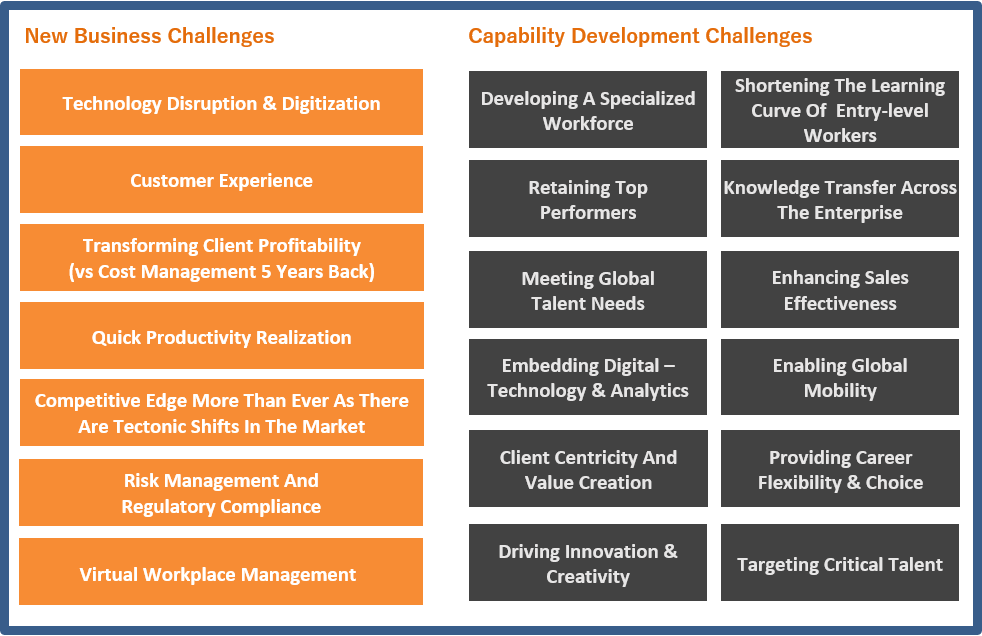INVITING APPLICATIONS
14th SSF EXCELLENCE AWARDS & RECOGNITION – 2025
LAST DATE: JUL-25 | APPLY NOW
Organization are operating in an environment where multi-dimensional shifts are a reality. And Talent requirement is of one of the key dimensions which are transforming. According to research, inadequate talent supply and critical skill shortage are two of the biggest concerns of CEOs today.
Successful organizations will need to have a relentless focus on talent outcomes.
There is a need to shift from being Process Managers to
Business Problem Solution Providers.
For BPM organizations the challenge on capabilities and leadership is even more pronounced, simply because the client expectations are evolving most drastically; and the C-Suite wants new providers, new leadership and replace legacy service providers with ‘As-a-service’ providers. Client needs are evolving rapidly with a significant premium on innovation and on business impact. Digitalisation has emerged both as a threat and opportunity. The value chain has moved from doing it cheaper and better to transforming a business. There is a need to shift from being Process Managers to Business Problem Solution Providers.

Changing business challenges are leading to people development challenges, even more so in this industry.
While knowledge and learning continue to be in the C-suite dialogue and remain a high strategic priority, most companies are still using the same approaches to capability development, as they were doing years back. The priority list of capabilities that organizations need have evolved to a large extent, but methods of building those skills have not.
Talent outcomes need to drive business outcomes and the Talent
agenda needs to be a crucial factor into shaping the business agenda.
Organizations remain overtly dependent on instructor led trainings, point in time execution, mass approach of ‘one size fits all’, siloed interventions and an input-focused, inside-out method.
Reshaping the Capability Development Charter
Capability Development and Learning needs to sit at the heart of the organizational strategy in today’s changed context. It needs to be central to the growth agenda, profitability, market share or similar mega organizational goals.
Talent outcomes need to be aligned with business outcomes and therefore, the Talent agenda plays a crucial role in shaping the business agenda. Multiple key capabilities, such as functional, domain, sales & leadership, need to be harnessed simultaneously and seamlessly, to start creating sustainable impact.
The most important trend in the industry is represented by clients wanting higher productivity leveraging digital and large digital-driven transformation. It is crucial for organizations to fully focus on developing a ‘Digital-Ready’ workforce.
Key imperatives to drive the above focus:
-
Talent strategy should be integral to the growth strategy – Anticipate, develop and deliver key capabilities for today & tomorrow. People development to be the cornerstone for each of the key organizational priorities
-
The enterprise wide talent pool should be mapped. Talent acquisition and development should be akin to a proactive supply chain management with accurate baselines and pipeline of hot-spot skill, knowledge and behavioural units
-
For BPM industry specifically - to cash in on the ‘Digital’ opportunity the critical focus should be on making people change-oriented, building domain expertise, enhancing digital & technological acumen and significantly building on analytics skills and mind-set.
-
Unleash the leadership potential by developing superior strategic thinking & communication ability
-
Build the ‘personal brand’ of leaders Build frontline capabilities not just to perform or towards increased performance, but to ‘Build the Business’ as well. Engage managers and clients to participate in their teams’ learning
-
Success of ‘Capability Development’ should be directly measured through key business metrics. Link learning to company performance
-
Deploy ‘multi-month graded Learning Tracks/ Paths’ with ‘before/ after’ impact measurement and on-job application
-
Build a multi-channel delivery mechanism using non-traditional methods of learning & sustenance, integrated through an enterprise wide Learning Management Platform
-
Use research heavily and continuously build an outside-in view of learning, content and practices
Stages of Learning Transformation
Learning space today takes characteristics of an active environment — flexible, collaborative, team-based, project-based, and add the capability of creating and making.
Stage 1 – Build Business Relevance
-
Link and baseline skills & knowledge to drive desired business performance
-
Identify key organization priorities and drive value by establishing Capability Development as an integral success factor
-
Build learning as a differentiator – to clients, with competition and with current & future employees
Stage 2 – Link to employee careers & build a learning culture
-
Build in learning & certification pre-requisites for any career progression
-
Reward learning achievements
-
Hold leaders accountable for learning
-
Build in an assessment culture & rigor
-
Communicate ‘Learning Heroes’
Stage 3 –Integrated Capability Development
-
Build technical, functional, domain, communication and leadership capabilities in tandem
-
Leverage business experience to enrich the Capability Development framework
-
Deploy multi-mode learning & create an enterprise learning portal
Stage 4 – Create a Knowledge organization
-
Create and deploy state of the art knowledge capture and creation mechanisms
-
Enterprise wide knowledge management to be the DNA
-
Co-create & deploy learning programs with clients
-
Build a powerful research engine
-
Manage ‘Knowledge’ as a key business metric
To Conclude
In summary, the Business Process industry landscape is changing rapidly. Some key trends that are driving this change are the transformation of traditional offerings, digitalisation taking center stage, technology led disruptions and an increased demand for flexible & integrated solutions. The Capability Development agenda needs to keep in lockstep with these trends and be central to drive all these changes and new capabilities.
There has to be deeper focus around futuristic and core-to-strategy capabilities, and training needs to be deployed more imaginatively to deliver to a globally expanding population of millennials. Learning needs to originate from and drive ‘strategy’ and conclude at sustainable business impact and outcomes. All of this should be underpinned by a Capability Development agenda which is central to the business agenda.

ABOUT THE AUTHOR

Sanjay Dutt has over 24 years of experience in the industry and is well recognized for his work in linking learning to business impact and his expertise around driving organizational strategies through Learning & Capability Development.
Sanjay leads the Capability Development function at EXL globally and spearheads many key organizational development initiatives in the organization. He also provides leadership to several key HR initiatives in India and across the globe. He has been responsible for setting up the EXL Center for Talent, establishing several Academies, launching and managing the program for our High Potentials and focused interventions to enhance Productivity, Customer Experience and Sales Effectiveness.
Prior to joining EXL, Sanjay was a Partner at Accenture, where he was leading Capability Development for their Outsourcing organization and was part of their India Leadership Team. Earlier, he worked for seven years with American Express where he was in a global leadership role around Performance Enhancement & Training.



 Ask an Expert
Ask an Expert



